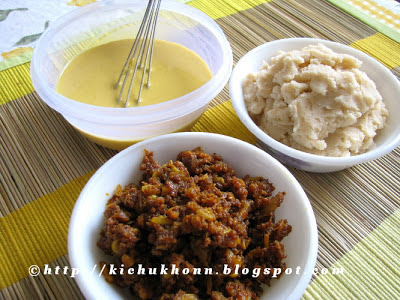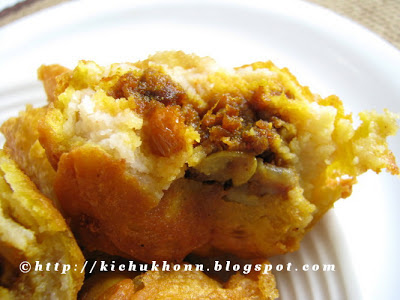A visit to the in laws house is always an uplifting experience for me.
Not soul wise, not the 'just enlightened and reached heaven and feeling all is well kind'. Just the energizing kind.
For a quiet Bengali girl, who has successfully maintained the peace and quiet in her life and home, the burst of life in all possible forms is enough to give a good shake and open up the eyes and look at the world with a new ... well ... vigour?
Yes, vigour ... that is it.
One step into the house and I am in a different world. The first thing that strikes me or my eyes is the colour. Or colours. Bright, cheerful, happy colours. Enough to transport the 'pure white loving' me ... who wears white, sleeps on white, decorates her home with white ...basically loves white and is a good target of constant jibs from the family .... to a new world.
But there's more.
People bustling around, calling out to each other, laughing and joking through out the day. Ma in law looks like a mini tornado .... everywhere at the same time, giving instructions, making sure everything is right, the proud mother whose son has come home.
Sometimes just watching them is enough to tire me out. And makes me say "Phew!" more than once in a day.
And the visitors .... uncounted, unlimited numbers of visitors. All through out the day there will some person or family visiting. Snacks being prepared, tea ... spicy with adrak and elaichi ... being served, sitting with them to give them company and sometimes having lunch or dinner ... depending upon the time of visit ... together. No respectable Rajasthani family will let their guests leave without having a proper meal or some heavy snacks.
During Diwali this scenario multiplies manifold. The energy, the get togethers, the whole family comes together ... uncles, aunts, cousins, their children, their visiting friends, distant uncles, aunts, their children ... the list is endless.
Dunk the very thin slices of the gilki in a bowlful water with a generous amount of salt added to it ( say around 2 tbsp) for around 20 minutes.
Prepare the batter by mixing together the besan, red chilli powder, hing, ajwain seeds and salt.
The batter should be very thin ... almost runny consistency.
Heat enough oil in a deep kadahi or open faced pan.
Remove the slices from the water, gently squeezing out extra water and put them into the besan batter.
Mix well.
Now slowly scoop out a palmful of gilkis and batter and spread on the oil make sure they do not stick together to make big sized lumps.
Fry well, turning once or twice ... till golden brown and crisp.
Remove with a slotted spoon on a kitchen napkin or paper tissues to drain excess oil.
Serve hot ... with chutneys or ketchup.
When you bite into it, you will get a mix of the spicy batter as well as the sweetness of the gilki inside.
Lovely ... I must say.
Great as a side to any meal or with a hot cup of tea in the evenings.
Enjoy !!
Not soul wise, not the 'just enlightened and reached heaven and feeling all is well kind'. Just the energizing kind.
For a quiet Bengali girl, who has successfully maintained the peace and quiet in her life and home, the burst of life in all possible forms is enough to give a good shake and open up the eyes and look at the world with a new ... well ... vigour?
Yes, vigour ... that is it.
One step into the house and I am in a different world. The first thing that strikes me or my eyes is the colour. Or colours. Bright, cheerful, happy colours. Enough to transport the 'pure white loving' me ... who wears white, sleeps on white, decorates her home with white ...basically loves white and is a good target of constant jibs from the family .... to a new world.
But there's more.
People bustling around, calling out to each other, laughing and joking through out the day. Ma in law looks like a mini tornado .... everywhere at the same time, giving instructions, making sure everything is right, the proud mother whose son has come home.
Sometimes just watching them is enough to tire me out. And makes me say "Phew!" more than once in a day.
And the visitors .... uncounted, unlimited numbers of visitors. All through out the day there will some person or family visiting. Snacks being prepared, tea ... spicy with adrak and elaichi ... being served, sitting with them to give them company and sometimes having lunch or dinner ... depending upon the time of visit ... together. No respectable Rajasthani family will let their guests leave without having a proper meal or some heavy snacks.
During Diwali this scenario multiplies manifold. The energy, the get togethers, the whole family comes together ... uncles, aunts, cousins, their children, their visiting friends, distant uncles, aunts, their children ... the list is endless.
Inspite of
all this, Ma in law never forgets to cook her son's favourite dishes.
They range from the very elusive bhawar laat ki fali and the very
special Dankheer or plain daily dals ... sirf Mummy ke haath ka is what
makes them so special ... or a huge range of chutneys.
The cook gets a respite at such times, when Mummy takes over the kitchen with gutso.
Among these things is the very simple Gilki ke pakode ... that Mummy makes with her own touch. And is savoured by all.
This
time she passed on the recipe to me and I marveled at how she rustles
up such tasty dishes with the minimum of ingredients. So much like my
way of cooking ... and am reassured am on the right track.
Gilki, or the Sponge gourd is a variety of the Ridge gourd ... except of course the ridges. Tastes the same though. Since it has almost no taste or flavour of its own, its accompaniments need to be slightly spicy or tangy ... especially for daily cooking or when making rustic dishes.
This pakode or battered frried version of the Gilki is made during the Navaratri ... and on Dusshera day. And that marks the end of eating gilki, a summer vegetable, for the rest of the year ... i.e till it reappears again in summer.
That is how our older generation instills eating seasonal fruits and vegetables in us ... with rituals, norms or tales.
In my home, it is enjoyed with the khichri, or when it rains ... or whenever the man turns nostalgic.
Need :
Gilki / Sponge gourd - peeled and cut into very thin roundels
Besan / Gram flour
Red chilli powder
Hing / Asafeotida
Ajwain / Carrom seeds
Salt
Water
Oil to deep fry
How to:
Prepare the batter by mixing together the besan, red chilli powder, hing, ajwain seeds and salt.
The batter should be very thin ... almost runny consistency.
Heat enough oil in a deep kadahi or open faced pan.
Remove the slices from the water, gently squeezing out extra water and put them into the besan batter.
Mix well.
Now slowly scoop out a palmful of gilkis and batter and spread on the oil make sure they do not stick together to make big sized lumps.
Fry well, turning once or twice ... till golden brown and crisp.
Remove with a slotted spoon on a kitchen napkin or paper tissues to drain excess oil.
Serve hot ... with chutneys or ketchup.
When you bite into it, you will get a mix of the spicy batter as well as the sweetness of the gilki inside.
Lovely ... I must say.
Great as a side to any meal or with a hot cup of tea in the evenings.
Enjoy !!




























